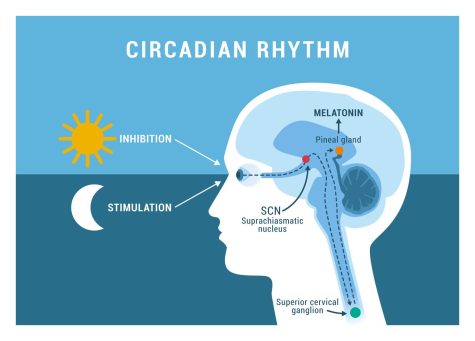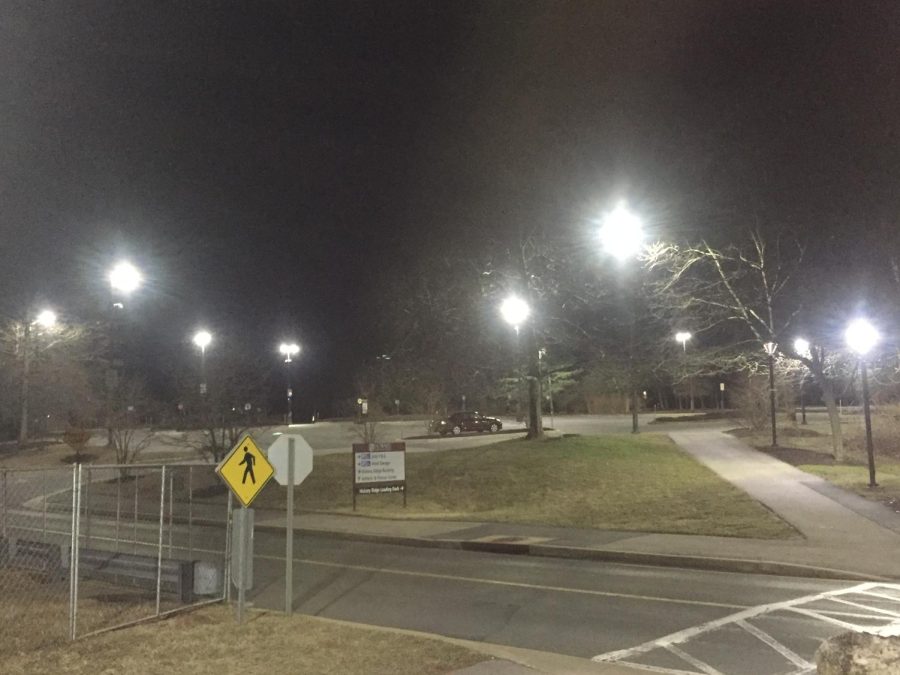The Ricocheting Rascal
Like little electric suns, these streetlamps beam out in all directions. Notice the smoggy appearance of the picture—sometimes cameras capture phenomena better than the eyes can perceive.
February 27, 2023
All of waking life balances upon the foundation of sleep. Each day’s beginning has its start marked by the return of consciousness to the body, the opening of the eyes, of an awareness allowing for movement of the limbs. The progression of day then leads to setting of the sun, a global signal to all creatures of the earth, heralding the coming of night. The moon silently makes its appearance and, looking down from above, floats amidst a curtain of black sky punctured by tiny pinpricks of twinkling little lights. Half the world might seamlessly enter the realm of dreams tucked beneath its blanket of darkness but for a cyclical clockwork anomaly.
In modern society, electric lights provide the backbone for productivity, the lifeblood that makes capitalism tick. Human beings inform their lives via the daily consumption of electronic media, and ensure the safety of themselves and others through the interpretation of blinking traffic signals while travelling at break-neck speeds. Without a persistent glow to peel back the shadows, rooms within buildings, factories and homes—container units for the 9-5 machine—would otherwise assume a state of dormancy in everlasting shadow.

Awash in an ocean of visual stimuli, society travels, works, cooks, cleans, learns and sleeps submerged in everlasting luminescence. Activity slows and ceases in the absence of light. The industrialized world has laid its foundation upon electricity and visibility.
Pollutants are typically thought of in terms of tangibles: trash, gaseous emissions, runoff. Three qualities—instantaneous transmission, ubiquity and, in particular, lack of substance—misconstrue light as deceptively harmless, yet it is perhaps the most insidious environmental pollutant in history. Artificial light pollution of electric origin is everywhere, transmogrifying night into day. It silently shoots through air, bounces off walls, beams into the eyes, ricochets off the ground and contaminates the sky on a nightly basis, resulting in a suspended black canvas pierced only by the brightest of stars.
In consequence, perhaps the greatest disappearing act of all time ensues: thousands upon thousands of stars, along with the Milky Way Galaxy itself, completely vanish, as if a mammoth chalkboard eraser passed across the sky in one obliterating swipe. According to the United Nations, nearly 99 percent of European and North American populations live beneath a sky obscured by the effects of light pollution. The nocturnal mysteries, birthright of those with eyes to see, are hidden from view.

Artificial light permeates the ecosystem, disrupting biological processes that depend on the cycle of light and dark. Trees with sensitivity to light may continue retaining their foliage well into the grip of the cold season; locked in the leaves, essential resources will freeze and fall to the ground instead of migrating back to the roots. The American toad, subject of a recent study conducted by Case Western Reserve University, experiences a disrupted rate of metamorphosis and altered behavior patterns resultant from chronic light exposure, as well as stunted growth.
Lit areas attract and distract migratory birds, siphoning their critical fat reserves and ending in exhaustion or collision. After hatching on the sand, baby sea turtles head towards the nearest, brightest source of light which, in times past, would have been the glittery ocean refracting the star and moonlight from above; instead, they are tricked: the hatchlings turn to the opposite direction, in pursuit of the beckoning far-off city glow that promises only starvation, dehydration and death.
Humans have internal circadian clocks that regulate chemical processes within the body. Melatonin, a hormone synthesized by the pineal gland of the brain, is instrumental in establishing the biorhythm that orchestrates the ebb and flow of sleepiness and wakefulness. Only in an adequate absence of light can melatonin be synthesized; the active act of perceiving light through the eyes disrupts the brain’s chemistry, consequently stifling production. A vast swath of scientific data collectively points to a highly significant correlation between a deficiency of nocturnal melatonin synthesis and breast cancer—the second most deadly cancer for women.
One such study conducted by the American Association for Cancer Research found melatonin to interfere with the growth of tumor cells. When the hormone estrogen attaches to receptors in breast cancer cells, it stimulates the tumor to grow. Melatonin suppresses the production of estrogen in the ovaries. The same study noted a high resistance to tamoxifen—an estrogen blocker drug used to treat breast cancer—arose when administered to animals exposed to light at night. The researchers postulated melatonin’s active suppression of estrogen to be the explanation for the dramatic difference in efficacy. The body’s natural defense system is neutralized nightly by an electric invention.

The results of a host of other investigations complement each other and tell the same story; in one, with a twisted irony, women who worked graveyard shifts were noted to have increased risk of developing breast cancer; in another, satellites photographed the density of light pollution in Israel, and, when analyzed, patterned out a massive increased risk of developing breast cancer in brighter areas of the country than darker; for a third, prevalence of breast cancer amongst over 10,000 women, each with some degree of visual impairment, was significantly inversely correlated between visual acuity and the disease, with completely blind individuals experiencing the lowest rate of susceptibility.
After awakening to the realities of a world basking in light pollution, how does one create a space conducive to good health? The answer is quite simple: turn off the lights! Shutting off or dimming cell phone and television screens hours before bed while, with discretion, selectively choosing only necessary light sources at night will aid dramatically in keeping the house dark when it is supposed to be dark. Computer and phone applications like F.lux, Deluminate and Night Shift turn screens orange or backgrounds black, and offer great ways to cut back on blue light emissions. Lights and switches equipped with passive infrared detector technology are powered on only when a person is present.
Installing either room darkening or blackout shades in the house will prevent streetlamps and neighborly sources of light pollution from uninvitedly penetrating the windows, helping to ensure adequate production of melatonin by the brain. Applying light shields to lampposts and streetlights—the latter of which the Maryland Department of Transportation is held responsible for if they receive complaints about the glow—effectively act as barriers, preventing light from shooting up into the sky and outcompeting the stars; instead, the shields redirect beams down towards the ground. Finally, communicating with friends, family and neighbors can collectively serve to make a significant difference towards reclaiming the natural darkness of night.
The perpetual presence of electric lights has created a modernized false “normalcy,” an aberration of the twenty-four-hour wheel of time. The ubiquity and utility of technology makes it a near impossibility to disengage from this manmade system. Enlightened with the knowledge of the gradual, subtle and insidious effects of light pollution on the biosphere, aware of the loss of the stars—when contemplating the direction in which this all leads, one cannot help but ask: is this progress?







